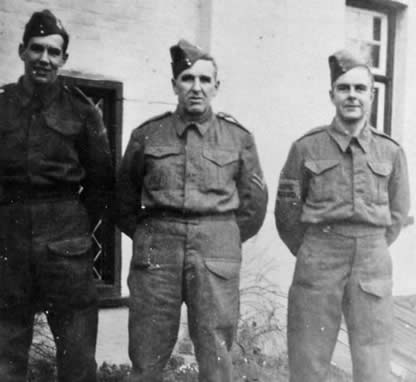
The Home Front
World War Two had an impact on everyone, not just those who were abroad in the services. In this part of the collection, we show how the war affected those on the Home Front, who were fighting the war in their own way, including experiences from day-to-day life and those who served in the Home Guard.
Longer summaries of some of the stories on this page are available here.
On an external site, there is a February 2020 interview with Stella Chandler about her time in the Land Army. It was conducted by Mike Stanyon of the Hemel Hempstead Local History and Museum Society and is available here. Further Home Front memories from Stewart Dunsford are on the BBC website.
The Herts Memories website has produced extracts from a journal kept by a Mr. A. S. Williamson who was a master of a school in the Holloway/Seven Sisters area of London, which was evacuated to the Hemel Hempstead area, 1st July 1940 to June 1941. They can be viewed here.
Nash Mills School pictured in 1922, as the main building would have appeared during WWII
(Photo provided by Nash Mills CofE Primary School.)
An air raid shelter at Nash Mills Church of England Primary School is still in existence. Constructed from brick, concrete and metal, the photos below show its current condition which is typical of many which have survived. The shelter is under a grass bank at the school, on one side if the playground, as pictured below. A school log book has been transcribed here and details some of the use of the shelter.
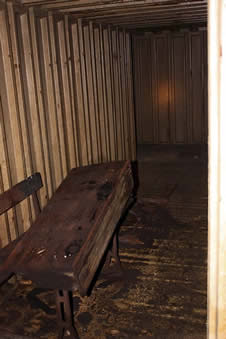
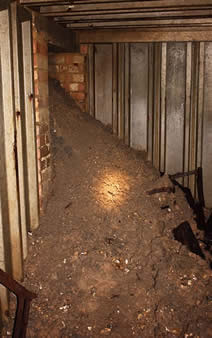
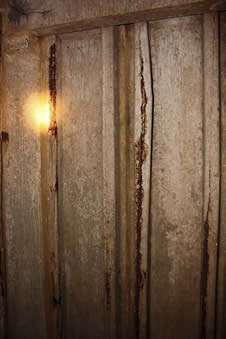
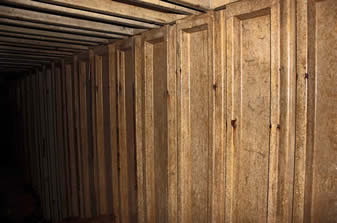
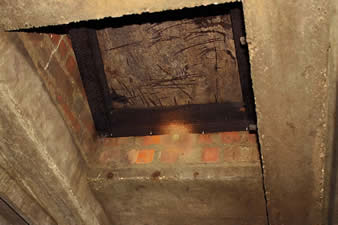
Inside the shelter today
(Photos provided by Nash Mills CofE Primary School.)
The shelter is underneath the grass bank
(Photo: Richard Grayson, 3rd March 2015.)
The school was also close to bomb damage on the opposite side of Belswains Lane as pictured below (photos provided by Nash Mills CofE Primary School). It is possible that these photographs are from the 10 May 1941 when nine people, listed here, lost their lives. Please contact us if you have any further information on this incident, such as a date.
Hemel Hempstead during the war
(Photos from Jean Stevens.)
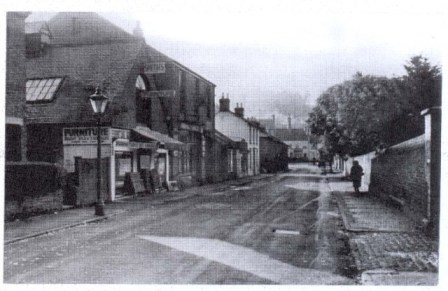
This photograph is of Bury Road (now Queensway) looking down from Marlowes to the Six Bells public house on the bend at the far end. The wall on the right is to The Bury. Stella Clarke's dancing academy was further down on the right. On the left was the TA drill Hall.
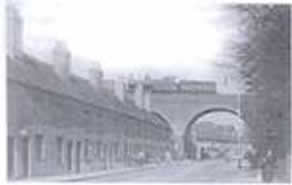
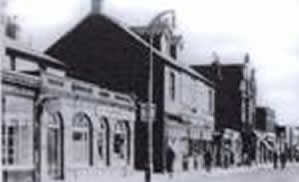
The Marlowes and the Nicky Line.
(Interview by Rory Tinker and Lynda Abbott, January 2012.)
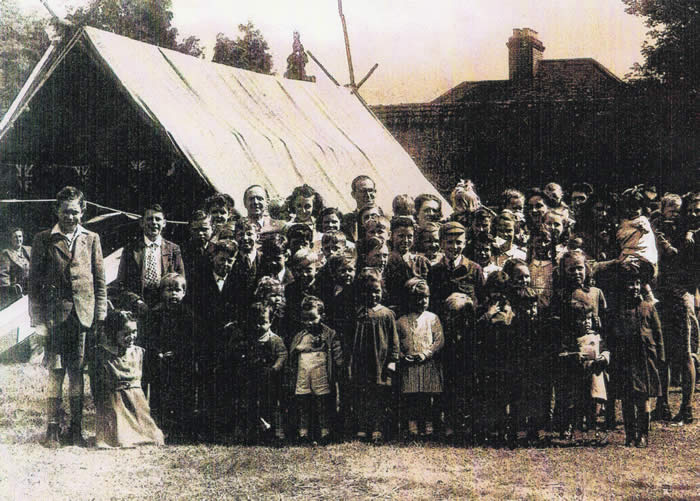
A 'VJ' (Victory over Japan) party in August 1945 in Lockers Garden. It was held by the residents of Bury Hill and Cemmaes Court Road. Lionel Howard is standing on the far left.
Lionel Howard grew up in Hemel Hempstead during the war. He has vivid memories of the war's impact on daily life.
I think the first thing I remember about the beginning of the war was the gas masks. They were in a little cardboard box with a string that went round your neck. When we were at school they were forever having practices. You had to hook them under your chin and then stretch them over your head. A great game, being boys, was if you breathed in deeply and breathed out quickly the air used to go out of the sides and made a weird noise.
Read more from Lionel Howard here.
(Information sent by individual, June 2009.)
Nancy Newberry has written about her wartime experiences.
Within a very short time our flower garden had been dug up and vegetables and small fruit bushes planted so that we always had plenty of fresh food despite the meagre allowance we had after ration books were introduced in January 1940. Rationing finally ended in 1954. As my mother had been a cook at Heath Brow School she managed what little food we did have very well.
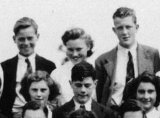
The photograph was taken at Hemel Hempstead Grammar School in 1949. Nancy is in the middle of the back row.
Read more from Nancy Newberry here.
(Information sent by individual, June 2009.)

Geoffrey Leggett has written about his wartime experiences.
[A] source of interest for Geoff during the war was the crashing of aircraft. In particular, American bombers seemed to be the most common source of such events perhaps because there were two military airfields not too far away from his home. On one occasion, he was told about an aircraft crash but it must have been some time after it actually occurred and there was not much of interest apart from some odd metal parts still lying around in the wood. There was another which also lacked interest but the third was a different matter altogether! This one was a huge bomber - an American Flying Fortress - which had crashed into a wood not far from his home near Little Gaddesden, Hertfordshire but remained largely intact apart from the wings which had been torn off by the trees, a wide strip of which had been cut short leaving a gap to the sky. There were no air force personnel on board when it crashed and, although the plane was severely damaged after crashing through a number of large trees, there was still a lot to be seen and found there.
Read more from Geoffrey here.
Yvonne Butler and Gwyneth Tomlin
(Interview by Nick Tate, Freya Martin and John Ross, November 2011.)
In a wide-ranging conversation about Hemel Hempstead life during the war, Yvonne Butler (then Chilman) and Gwyneth Tomlin (then Daniels), who both attended Hemel Hempstead Grammar School, told us about school, sweets and air raids.
Gwyneth - If the Germans were coming back from somewhere like Coventry and places like that, they would “ stick bomb” down the valley because at that time, this valley had the main canal, the main road – the A41 – and the railway lines all coming through and they would try to disrupt munitions and things coming from Birmingham through to the docks.
Yvonne - Sweets were rationed and we had the equivalent of one crunchy bar a week. I used to save mine up. The local shop would save me four crunchy bars at the end of the month and that was my sweets for the month.
Read more from Yvonne and Gwyneth here.
John Stanbridge
(Interview by Lynda Abbott and Fay Breed, November 2011.)
John Stanbridge attended Hemel Hempstead Grammar School as part of its second intake. His experience at school can be read about here. Later, he farmed St Agnell’s farm in partnership with his father, as SG Stanbridge and Son, and during the war was a member of the Home Guard, as described below.
John told us about his memories of German prisoners of war on the farm:
They were absolutely superb. Of course, they’d all been screened so there were no Nazis amongst them and they all came from farming backgrounds. I remember one winter – I was in charge of a hedging gang. They were used to obeying orders; whatever you told them to do they did it and they didn’t try to keep the job going on to avoid new tasks.
Even on a farm, rationing made an impact:
Rationing affected us. If you hadn’t got potatoes and swedes in winter you would have been in trouble. Until myxomatosis, which was after the war, we killed quite a few rabbits. Rabbit was the main meat during the war. Nearly all our hay production in the war went to London to feed rabbits. Fruit was impossible which I found particularly painful.
Read more about John's farm life here.
Peter Mullard
(Interview by Sophie Horwood, November 2008.)
Peter Mullard was seven years old the month war broke out, September 1939. He was just about to start George Street Junior School, and lived in Herbert Street in Hemel Hempstead. In 1943 he later moved on to the secondary school in Crabtree Lane. Peter Mullard tells what it was like to be at school during an air raid. He describes how the shelters were partly underground and says:
It was dark down there, but we were not really scared because we were all in it together. I seem to recall that there was some form of artificial lighting, probably paraffin lamps. We sat on benches facing each other. There was no heating. We spent many hours in the shelters, particularly when the V1 (Doodlebug) attacks started followed by the V2 rockets. I believe I am right in saying that we did some of our end of year exams in 1944 sitting in the shelters.
Read more about Peter Mullard's experiences, including his descriptions of Hemel in 1939-45 here.
Barrie Chiverton
(Information sent by individual, July 2009.)
Barrie has written about his experiences in Hemel during the war:
When the air raid sirens went at school, we had to move into the corridors and sit on mattresses. Of course the frightening times were when we heard the drone of the doodlebugs stop. That was when we were told that the explosion would be ten seconds after the sound stopped. We all cheered up when the all-clear continuous siren sounded, as thankfully no bombs or doodlebugs landed near us.
At home we had a couple of soldiers billetted with us for a while, but not at the same time. We also had two young boys of my age, also at different times. They were evacuated out of London's Cricklewood area to be safer in Hemel. I remember that one of the boys ran away the day after he arrived - he wanted to be back with his mum!
Coxpond, which was later filled in, was an attraction for us kids, but during the war it was used by the army, including the US army, for submersion trials. The army vehicles, tanks as well, ran in one side of the pond and out the other, probably getting half-submerged. The water sensitive parts of the engines had been covered with a heavy, smelly wax for the trials. We kids loved to be around because we got rides and sweets/chewing gum from the soldiers.
Read more from Barrie here.
Vera Dormer
(Interview by Fiona Wright and James Moss, July 2009.)
Vera told us about rationing:
It was awful. In fact, when I think back now, I don’t know how my Mum fed us - there were four of us in the family. I remember coming out of the factory where I worked one Saturday morning, and just along the Broadway there was a greengrocers called Leago's and I used to go in there and get vegetables and things like that. I was one of their customers. One day I realised there was a queue. ‘Oh great, I’m going to get on the end of this queue.’ Mrs Leago came out and she looked along the queue and she said, ‘Vera, come along, you’re one of my customers. You don’t need to queue.’ I came out of the queue - I thought ‘Oh dear, Oh dear’ and went straight in the shop and I suppose got about four bananas. But that walk of shame! It was dreadful! You could imagine all the other people standing there. What were their thoughts, I wonder?
Read more from Vera here.
Pat Smith
(Information sent by individual, January 2013.)
Pat has been writing his memoirs and explains in a chapter dealing with the early war years:
July 1940 saw me leave the world of the classroom and enter the workplace…. for the August and September of that year, despite the threat of invasion and the general uncertainty, I spent the time with my friends playing tennis most days and with glorious weather for the majority of the time, out in the local countryside enjoying ourselves oblivious to the perilous situation which hung over the country. I cannot remember being the least bit worried about the uncertain future.
Read more from Pat here.
The Home Guard
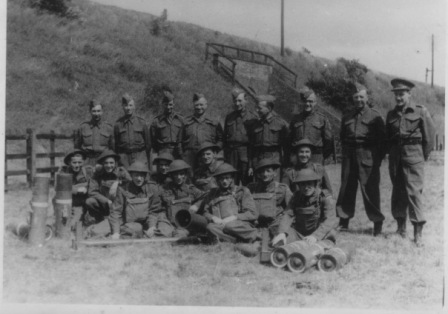
Boxmoor Home Guard on exercise opposite The Swan at the foot Edward Grayson
of Box Lane.
Many of the members of the Home Guard were veterans of World War One. A Hemel resident who fell into this category was Edward Grayson who served in the Boxmoor Home Guard. Originally from Lurgan in County Armagh, he served in the Royal Flying Corps and Royal Air Force in WWI. Edward Grayson came to Hemel Hempstead with his wife and children in 1939. He was working as a customs official and had been posted to Bovingdon airfield. With war looming, the family was pleased to move further away from London, moving to Hemel from Wanstead Park Road, Ilford. As so many feared the effects of bombing on London, some thought had been given to sending the children back to the family farm at Kinnego, County Armagh. However, in 1939 they settled at Little Heath Lodge in Felden. When war broke out, Edward Grayson soon joined the Home Guard which contained many other men who had seen service in the First World War.
John Stanbridge (interviewed by Lynda Abbott and Fay Breed in November 2011) was another member of the Home Guard. He remembers:
We were called the Local Defence Force and Churchill re-named it the Home Guard. A very clever move that was and not only that, they took it further. They made us a section of the British Army and our officers were given full commissions. We were allowed to wear the Herts badge on our caps and that’s when morale went up tremendously.
John Stanbridge (left) with other members of the Home Guard
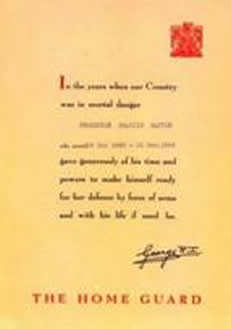
A certificate given to Frederick Baxter in
recognition of his service in the Home Guard.
Source: Jean Stevens
Winifred Lawrence (interviewed by Sophie Horwood and Zoe Burrell) remembers:
My husband was working with the waterworks and did home guard duty on the railway. They didn’t have guns or anything, only sticks, so how they were supposed to defend anything, I don’t know. We had a semi-detached house and they took our railings and the gates because they wanted metal to make munitions.
Read more from Winifred Lawrence here.
Eric Kemp
(Interview by Richard Grayson, May 2020.)
Eric remembers a few ‘Doodlebugs’ (V1 Rockets) over Hemel after overshooting London, including one which exploded at the top of Featherbed Lane. On another occasion, Eric was playing football on the moor. The danger sign with a V1 was to hear the engine cut out as it meant it would soon fall to the ground. Eric described it ‘flying straight up the valley, quite low’. He and his friends watched it, waiting for the engine to cut out but it did not. At the same time, a Mosquito took off from Bovingdon and shot it down, probably near Tring, judging by Eric’s recollection of the explosion.
Read more from Eric Kemp here.
